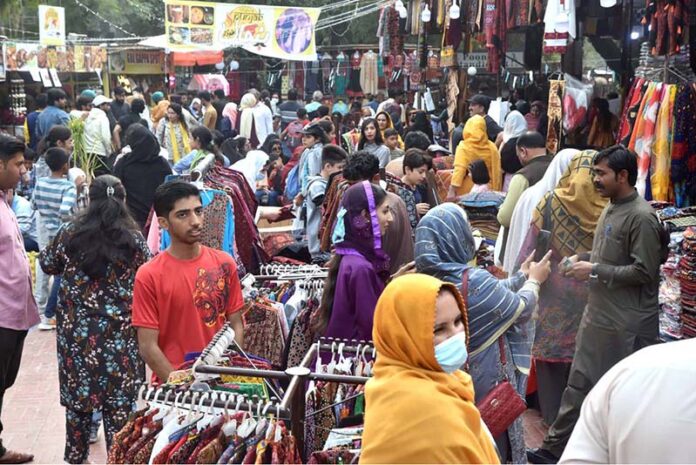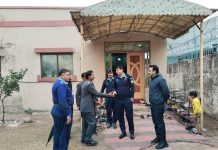ISLAMABAD: The lively Lok Mela festival has evolved from a celebration into a vital support system for the country’s diminishing traditional crafts, allowing artisans nationwide to display their creations, earn recognition, and preserve their ancestral legacies.
Lok Mela stands as a beacon of hope in a rapidly modernizing world where centuries-old crafts often face the risk of extinction. This year, a significant number of young artisans graced the festival, many of whom were apprentices learning the trade under the tutelage of their elders.
Participation of these artisans has reflected a growing interest among the youth in preserving the cultural treasures of their regions.
Samia Inam, a wholesale cloth entrepreneur, shared her journey of employing women from Bahawalpur to produce exquisite hand-embroidered garments. Her dresses, ranging from Rs. 3,000 to Rs. 10,000, exemplify intricate craftsmanship. While buyers increasingly lean towards branded outfits, Samia believes the uniqueness and durability of hand embroidery are regaining popularity.
However, she noted a disparity in earnings, with artisans from remote areas working for minimal wages while sellers earn significant profits.
Naeem Soomro, a Kashigar from Hala, Sindh, captivated visitors with his display of Kashi Kari products such as jars, vases, and fountains. This ancient art form, traditionally limited to blue and white colored designs, has evolved with vibrant colors to meet modern demand.
While Naeem takes pride in continuing his family’s legacy, he lamented the intense labor required and the younger generation’s waning interest in the craft. Yet, training centers in Hala are striving to keep the art alive for local and international markets.
While Lok Mela provides a vital platform for artisans, many expressed concerns about low profitability, lack of patronage, and diminishing interest among the younger generation. But still, events like these bring hope, connecting craftspeople with larger audiences and opening doors to new opportunities.
Shahid Hussain of Khairpur is preserving the craft of ‘Lungi and Khes weaving’, a legacy handed down by his mother, Siyani Khatoon who is a Civil Award recipient.
Despite the admiration for handmade shawls, Shahid faces declining demand due to the availability of cheaper, machine-made alternatives. He emphasized the need for government support to ensure the survival of these labor-intensive yet culturally significant crafts.
Raiban Baloch from Balochistan brought a unique touch to the Lok Mela with her stall of date-leaf products, including table mats, baskets, and pen holders. Having earned over Rs. 60,000 throughout the event, she highlighted the arduous nature of her craft and the reluctance of her children to continue this unprofitable tradition.
Denaar from Chitral at a stall featured Kalashi handmade caps, dresses, and ornaments, items admired for their uniqueness worldwide. She expressed concern over the economic viability of such crafts, advocating for their promotion in larger markets while encouraging the younger generation to prioritize education alongside cultural preservation.
For many young artisans, Lok Mela is not just a marketplace but it is an affirmation of their value in preserving Pakistan’s cultural identity. The recognition and appreciation they receive at the festival boosts their morale and their commitment to crafts.
For Noor-e-Sahar, a student from Kashmir said, Lok Mela provided her first taste of entrepreneurship. Her stall featuring Kashmiri tea, kulchas, and homemade cupcakes drew overwhelming praise.
Inspired by her initial success, Noor is planning to continue blending her academic pursuits with her passion for showcasing Kashmiri culinary culture through such platforms.
Amir Hamza, a young boy from Peshawar expressed his passion for designing handmade jewelry, including earrings, necklaces, bracelets, and rings. Despite modern trends, these intricate pieces continue to attract customers, reinforcing the timeless charm of traditional craftsmanship.
Similarly, Sana Ansari, who has specialized in jewelry design since completing her education at the Indus Valley School of Arts, shared her journey of blending artistic innovation with cultural heritage.
The annual feature of Lok Mela arranged by the National Institute of Folk and Traditional Heritage (Lok Virsa) served as a reminder that cultural heritage is not just a relic of the past but a living, breathing part of our identity. By inspiring the youth to embrace and evolve these traditions, Lok Mela ensures that Pakistan’s cultural tapestry remains vibrant for future generations to come.
The festival also underscores the urgent need to support traditional arts through market access, government patronage, and youth engagement to ensure these crafts not only survive but thrive in the years to come.






